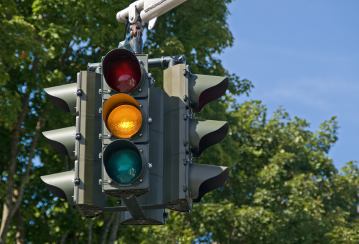News and Updates
Caution light crashes: Who’s at fault?
A caution light, also known as an amber or yellow light, warns drivers that a red light is about to appear. This means the driver should stop if safe to do so; otherwise, proceed with caution. But what happens when a driver’s choice to proceed through an amber light results in a collision? Read on for more information about caution light rules, fault determination and tips for avoiding caution light crashes.
Rules of the road for caution light intersections
In Ontario, traffic regulations are governed by the Highway Traffic Act (HTA). According to the HTA, drivers must stop for a caution light if they can do so safely. If it is not safe to stop, the driver may carefully proceed into the intersection. If the driver is attempting to turn left through the intersection at a caution light, they must ensure they can complete the turn safely.
Common causes of caution light crashes
Common causes of caution light crashes include:
-
Running a caution light: When a driver fails to stop at a caution light intersection or accelerates to “beat the light”.
-
Failure to yield to other drivers: When a driver fails to yield to other drivers who have the right of way at a caution light intersection.
-
Speeding: When a driver approaches a caution light intersection at a speed that is too fast to stop or yield safely.
-
Rear-end accidents: When a driver slows to stop at a caution light or to prepare for a turn and is rear-ended by the driver or motorist behind.
Determining fault in caution light crashes
In a caution light collision, fault is typically assigned to the driver who failed to stop or yield at the intersection. Especially if they were attempting to make a left-hand turn. According to Canadian Underwriter, it is more common for left-turning drivers to be found at fault for caution light collisions than drivers proceeding straight through the amber light.
If you are involved in a collision, your insurer will perform an investigation to determine your level of responsibility for the cause of the accident. In addition to the traffic signal and your direction of travel, your insurer will also consider other factors, such as your speed and distance from the intersection. Your degree of fault can be anywhere between 0% to 100%.
Tips for avoiding a caution light crash
The best way to prevent yourself from being found at fault for a caution light accident is to avoid one altogether. While you can’t control the actions of other drivers, there are steps you can take to prevent an amber light accident.
-
Slow to a stop. The caution light is a sign of slowing down, not speeding up. Begin slowing your vehicle when you see the traffic light turn amber. This gives you a better opportunity to observe your surroundings and safely come to a stop.
-
Obey the speed limit. While you should always follow the posted speed limit, obeying the limit gives you more time to slow down at a caution light.
-
Yield to oncoming traffic. If you’re attempting to make a left-hand turn at a caution light, remember that oncoming traffic has the right of way. If you haven’t started your turn, wait until the light turns green. If you’ve already begun your turn, wait until the intersection is clear and proceed carefully.
-
Keep a safe distance. Following a safe distance behind the vehicle in front of you ensures you have enough time to slow down and stop at a caution light.
Sometimes accidents happen, even to the most cautious drivers. That’s why knowing you have the coverage you need to get back to where you started is essential.
If you’re a current OTIP policyholder, contact us at 1-833-494-0089 to review your existing auto policy and discuss additional coverage options. If you're not insured with OTIP and shopping for auto insurance, call us at 1-833-615-9326.





